Why do we kiss under the mistletoe? Of all the plants used in Christmas decor, not many have as long and as interesting a history as mistletoe. Discover the meaning of mistletoe and fascinating folklore behind it.
Advertisement
First of All, What Is Mistletoe?
With evergreen leaves, yellow flowers, and white berries, large clumps of mistletoe are usually observed growing high in the canopies of fruit trees, maples, and sometimes oaks. Although it has a strong association with Christmastime kissing, in reality, the mistletoe plant is not very romantic: the plant is a parasite, attaching to its host tree of choice and siphoning off water and nutrients for itself. (In other words, it's a bit clingy.)
Mistletoe is most easily spotted in winter. Look for ball-shaped green masses on otherwise bare tree branches. How do they get there, you ask? Birds eat the white berries and spread the seeds while sitting on the branches. The seeds adhere to the bark of the tree and germinate, relying on photosynthesis to provide the necessary energy to grow at this stage of life. The seedlings then burrow their makeshift roots into the bark of the tree and begin to sap nutrients and water from it using a specialized structure called a haustorium.
Once fully attached to its host, mistletoe lives its life out as any other plant would, flowering, fruiting, and spreading far and wide! Romantic, eh?
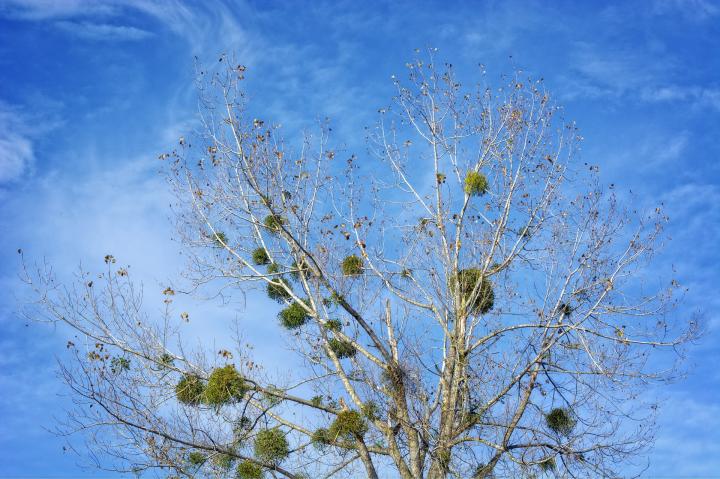
Why Do People Kiss Under Mistletoe?
We all know about the tradition of kissing under the mistletoe, but do you know how that came about?
In an old Norse legend, Frigga, the goddess of love, had a son named Balder who was the god of innocence and light. To protect him, Frigga demanded that all creatures—and even inanimate objects—swear an oath not to harm him, but she forgot to include mistletoe. Loki, god of evil and destruction, learned of this and made an arrow from a sprig of mistletoe. He then tricked Hoth, Balder's blind brother, into shooting the mistletoe arrow and guided it to kill Balder. The death of Balder meant the death of sunlight—explaining the long winter nights in the north.
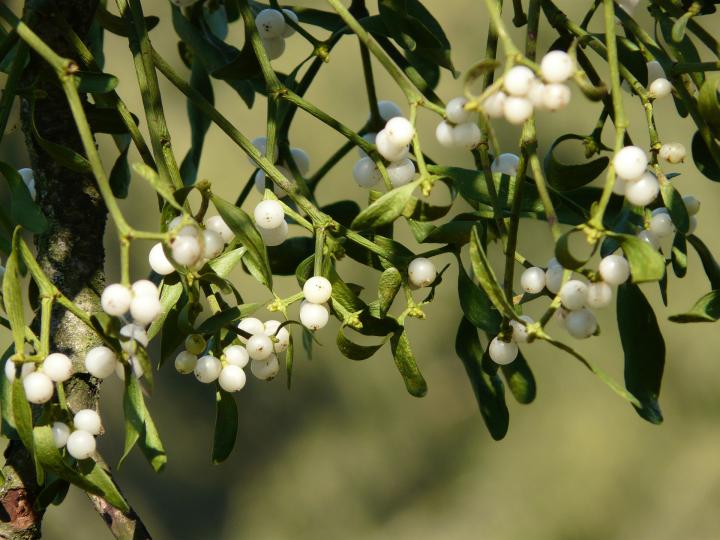
Frigga's tears fell onto the mistletoe and turned into white berries. She decreed that it should never cause harm again but should promote love and peace instead. From then on, anyone standing under mistletoe would get a kiss. Even mortal enemies meeting under mistletoe by accident had to put their weapons aside and exchange a kiss of peace, declaring a truce for the day.
Known as "the healing plant," mistletoe was also used by the ancient Celts and was a big part of their winter solstice celebrations. The plant contains progesterone, the female sex hormone, and perhaps this is another why it became associated with kissing.
Balls of Mistletoe
By the 1700's, traditional "kissing balls" made of boxwood, holly, and mistletoe were hung in windows and doorways during the holiday season. A young lady caught under the mistletoe could not refuse to give a kiss. This was supposed to increase her chances of marriage, since a girl who wasn't kissed could still be single next Christmas. According to ancient custom, after each kiss, one berry is removed until they are all gone.
Mistletoe Meaning, Legend, and Folklore
Mistletoe is considered a symbol of life because even when its host is leafless, it is evergreen and bears fruit in the winter. The word mistletoe is thought to stem from Saxon mistl-tan, meaning "different twig."
Druid priests thought mistletoe to be a sacred plant because it didn't grow from roots in the ground. When they found some growing on an oak—their most sacred tree—they considered it to be the soul of the tree. The high priest would climb the tree on the 6th night of the new Moon after the winter solstice and cut the mistletoe with a golden sickle. Worshippers caught the pieces in their long white robes or on a white cloth spread under the tree because it was bad luck to let even the smallest piece touch the ground. The faithful would wear mistletoe charms for good luck and protection from witches and evil spirits. Sprays of mistletoe hung over the doorway ensured that only happiness could enter the home.
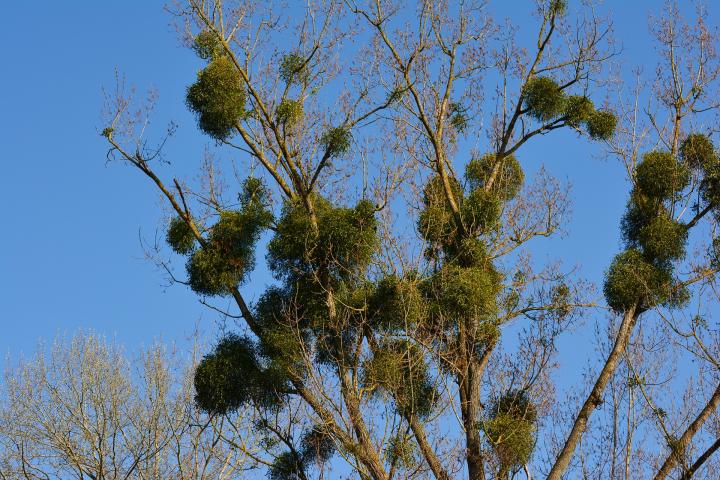
The Swiss traditionally shot mistletoe out of the trees with an arrow and for good luck they had to catch it in the left hand before it hit the ground. It was also associated with lightning and fire, and subsequently called "thunder-besom." In some parts of northern Europe, it was used as a divining rod to find treasure and as a master key to open locks.
According to the language of flowers, mistletoe symbolizes overcoming difficulties.
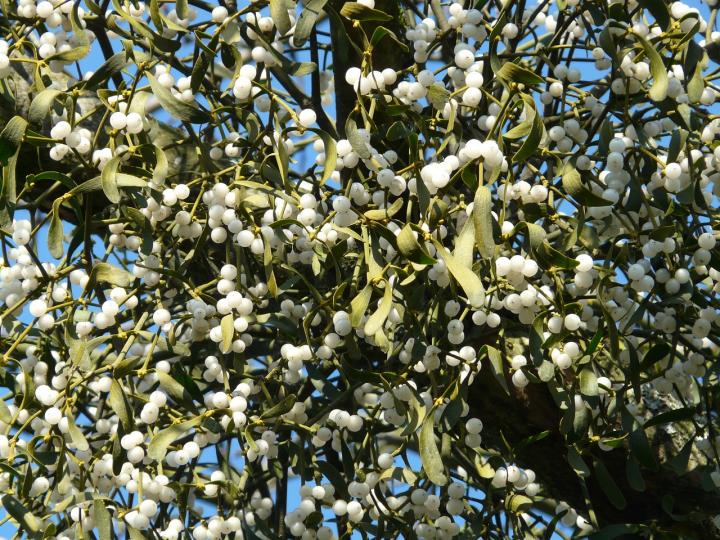
Can Mistletoe Kill a Tree?
Yes and no. Mistletoe makes most of its own food but depends on the host plant for water and minerals. This can weaken and eventually kill the host tree. A healthy tree won't have a problem and mistletoe even encourages birds and beneficial insects. However, an infestation of mistletoe can be harmful. To rid your tree of mistletoe, it's essential to prune the infected branches in wintertime; just pruning off the plant will not destroy the parasite which has now become a harmful pest.
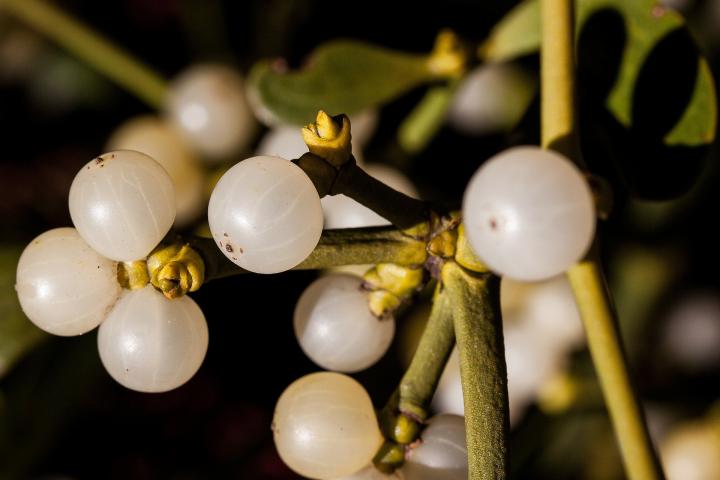
Is Mistletoe Poisonous?
One caution—raw mistletoe berries are very poisonous and tend to fall off the plant easily. They have been known to cause seizures or death when ingested and can be especially lethal to children and pets. See more about plants that are poisonous to pets.
To be on the safe side, ask your florist to replace the real berries with imitation ones or just use artificial mistletoe in your decorations.
Now, pucker up!
Discover more plants of the winter solstice.















Comments